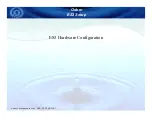
Chapter 2 — The Potentiostat
7
coaxial shields which are maintained at the respective electrode
potential.
Electrode Cable
The Potentiostat is supplied with an electrode cable comprising three
leads, with each lead terminated by an alligator clip. The Reference
and Working electrode leads are shielded to protect the signals from
external interference. The alligator clips allow connection to a wide
variety of electrodes, and the leads are color–coded to indicate the
type of electrode to which they should be attached (
For normal three–electrode potentiostat,
, use, the reference electrode must never be connected to
either the auxiliary (red) or working (green) leads, otherwise the current
that would be passed through the electrode could effectively destroy it
as a reference potential source.
When two–electrode potentiostat, or galvanostat, operation is required
the auxiliary and reference leads (red and yellow) should be attached
to the single ‘counter electrode’. The green lead is attached to the
working electrode.
When using in
ZRA
(zero resistance ammeter) mode, connect the
working (green) and auxiliary (red) leads to the two electrodes (or
circuit test points) across which to measure the current,
reference lead (yellow) can be connected to a reference electrode (or
circuit test point) to measure the potential difference to the auxiliary
(and working) leads.
When using
High Z
(high impedance) mode, connect the working
(green) lead to one electrode and the reference lead (yellow) lead to a
reference electrode to measure the potential difference between the
leads,
. The auxiliary lead (red) can be connected to a third
To ensure good grip, the
electrode cable alligator
clips use a spring made
from a good quality steel
(stainless steel is
unsuitable for springs).
Avoid wetting of the
alligator clips, especially
with electrolyte solutions
which can hasten
corrosion. If the alligator
clips are wetted then
immediately disconnect
from the Potentiostat,
rinse the clips with a
little deionized water
from a wash bottle, to
remove the electrolyte,
and immediately dry by
patting with paper
tissue. The whole cable
must then be allowed to
dry thoroughly (several
hours at least) before
reuse.
Never immerse any part
of the electrode cable in
water, or other liquid!
Color
Electrode
Yellow
Reference
Green
Working
Red
Auxiliary
Table 2–1
Color–coding on the
leads of the electrode
cable.
Summary of Contents for Picostat
Page 8: ...4 eDAQ Potentiostats ...
Page 28: ...24 eDAQ Potentiostats ...
Page 44: ...40 eDAQ Potentiostats ...
Page 64: ...60 eDAQ Potentiostats ...
Page 104: ...100 eDAQ Potentiostats ...
Page 112: ...108 eDAQ Potentiostats ...












































